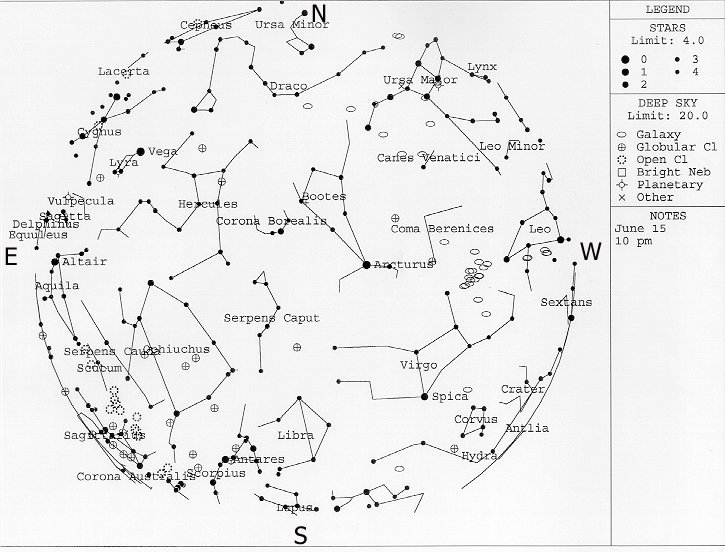What's to see in the night sky in June?

This chart represents the sky as it looks at around 10 PM local
time. Some adjustment should be made for longitude, but it shouldn't be much. Right click on
the chart, select "Save As" and save the image. You can then print
this chart from a photo application, like Print Shop Pro, hold it in front of you with the
direction you are facing at the bottom. Then, raise it above your head and you should be
able to find your way around from there.
=====================================================================
Moon phases
Planets
The June Bootids begin on June 26 and peak on the June 27. This is a highly
variable shower, ranging from 0 to 100+ meteors/hr. Unpredictable, but it may be worth a look.
Click on the IMO link above for a locator chart, or email me and I'll be happy to help you
find the radiant.
Deep Sky Objects (DSO's)
If you like galaxy hunting, this is the month for it! The Virgo/Coma cluster is nicely placed,
and if you can't find galaxies there, it's time for a bigger scope. :-) There are 17 Messier
galaxies here, not to mention hundreds of NGC's, too. I won't cover them all, but my favorite
grouping invloves M84 and M86-right at the head of what's called "Markarian's Chain". Consult
a detailed chart for navigation through this rich galactic region. Named DSO's
Omega Centauri This is the finest globular cluster visible in the northern
hemisphere, if you happen to be south of ~35º N. Latitude. Easy to find using Spica in Virgo
and the 2 eastern stars of Corvus. Use Delta, the top left star, and Beta, the bottom left star
as a pointer to the south. Omega is at the same right ascension as Spica, close to the line
described by Delta and Beta Corvi. It's visible easily in binoculars, but if you find it
in even a modest telescope, prepare to be absorbed! :-)
Here's the link to SEDS as promised.
The Grand Canyon Star Party is between 6/18 and
6/25/11! If you're in the neighborhood, drop by North Rim at sunset and stay late!
There'll be lots of scopes of all different descriptions set up, with enthusiastic volunteers
to show you the sky's wonders! It's always fun!
New-6/1_____First Quarter-6/8____Full-6/15____Last Quarter-6/23
Mercury
Venus
Mars
Jupiter
Saturn
Messier Objects
The best galaxies here not associated with Virgo are M51 in Canes Venatici, famous for
the 2 galaxies together. Very nice. The other "best" is M104-the Sombereo Galaxy. To find it,
draw a line between the lower right star in Corvus through the upper right star and half way to
Spica, there it is to the right, more or less. It's about 10 million light years closer than
the Virgo cluster and shows the dark dust lane around the center nicely in good conditions in
a 6" scope. Worth a try!
M53 and M3 present a couple of nice globular
clusters for variety. :-) They'd both be showpieces nearly anywhere else in the sky.
January's page
February's page
March's's page
April's page
May's page
June's page July's page
August's page
September's page
October's page
November's page
December's page

